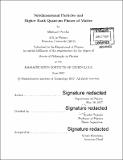Subdimensional particles and higher rank quantum phases of matter
Author(s)
Pretko, Michael
DownloadFull printable version (11.69Mb)
Other Contributors
Massachusetts Institute of Technology. Department of Physics.
Advisor
Senthil Todadri.
Terms of use
Metadata
Show full item recordAbstract
Many quantum phases of matter, such as quantum spin liquids and fractional quantum hall systems, are well-described in the language of gauge theory. Until recently, most theoretical attention has been focused on systems described by familiar vector gauge theories. In this thesis, we will explore the properties of quantum phases described by higher rank tensor gauge theories. In particular, symmetric tensor gauge theories describe stable phases of matter in three dimensions. We will demonstrate that these theories lead to an exotic new class of particles which are restricted to move only in lower-dimensional subspaces, instead of being able to freely propagate in three dimensions. We call these excitations "subdimensional particles." As a special case, some models feature 0-dimensional particles, or "fractons," which are totally immobile. Subdimensional particles couple naturally to tensor electric and magnetic fields, in a form of generalized electromagnetism. We will establish the basic theoretical principles of this new tensor electromagnetism, including its Maxwell equations, force laws, and electrostatic properties. Finally, as a special case of the higher rank formalism, we will study a rank 2 phase featuring a gravity-like low-energy theory. We will show how to reconcile the restricted mobility of tensor gauge theories with the expected properties of a gravitational theory. Our toy models will thereby offer clues which may be useful for understanding more realistic gravitational theories.
Description
Thesis: Ph. D., Massachusetts Institute of Technology, Department of Physics, 2017. Cataloged from PDF version of thesis. Includes bibliographical references (pages 139-143).
Date issued
2017Department
Massachusetts Institute of Technology. Department of PhysicsPublisher
Massachusetts Institute of Technology
Keywords
Physics.